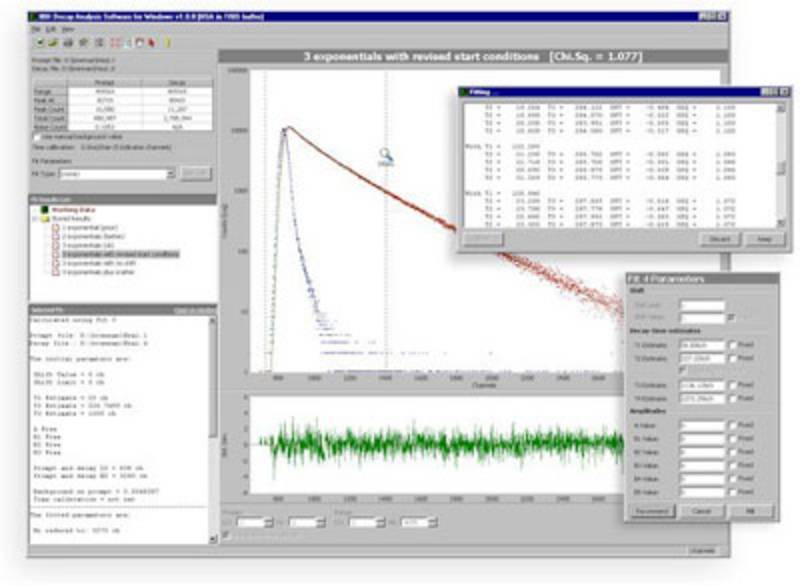Requirements
DAS6 runs on 32-bit and 64-bit versions of Windows including Windows 7. A minimum display resolution of 1024 x 768 is required.
Decay Analysis Software
HORIBA Scientific decay analysis software recovers kinetic information (such as fluorescence lifetime and rotational correlation times) from luminescence decay data by fitting the raw decay data to one of a selection of kinetic models.
HORIBA Scientific decay analysis software recovers kinetic information (such as fluorescence lifetime and rotational correlation times) from luminescence decay data by fitting the raw decay data to one of a selection of kinetic models. Features such as shift iteration and reconvolution of instrument response function (IRF, or "lamp" profile) allow accurate recovery of multiple decay components even when the decay data is grossly distorted by the IRF.
DAS6 is designed to streamline the analysis of time-domain luminescence data, while still allowing for fine-tuning of parameters where necessary. Analysis modules include reconvolution analysis of multi-exponential models plus analysis of more specialised fluorescence decay processes as detailed below.
Analysis for up to 5 exponentials.
Batch mode supports datasets containing up to 10,000 decays and is ideal for applications where large amounts of lifetime data are generated e.g. lifetime imaging and reaction monitoring. It features full reconvolution with up to five exponentials and shift iteration.
Perform global analyses of up to 5 exponential components and 100 decay curves.
Two methods are available for performing lifetime distribution analysis. The first method employs a “Top Hat” distribution function which allows a single lifetime distribution to be fitted in conjunction with an additional discrete lifetime. The second method is an optional module which will perform a Non-Extensive Decay distribution which allows up to five lifetime distributions to be modelled.
Exponential series analysis of up to 30 terms. This allows parameterisation of otherwise difficult data.
2D and 3D Foerster type energy transfer with an optional exponential component.
Yokoto-Tanimoto energy transfer taking into account diffusion with an optional exponential component.
Micellar quenching kinetics can help determine the surfactant aggregation number.
Exciplex analysis follows formation of an excited state species.
Impulse reconvolution of up to 2 correlation times and 5 fluorescence decay components. Each model parameter, including shift, can be fixed at a pre-determined value or optimised as part of the parameter fitting. The use of reconvolution allows accurate determination of decay times and rotational correlation times even when the observed decay is grossly distorted by the duration of the excitation pulse.
Requirements
DAS6 runs on 32-bit and 64-bit versions of Windows including Windows 7. A minimum display resolution of 1024 x 768 is required.
Sie haben Fragen oder Wünsche? Nutzen Sie dieses Formular, um mit unseren Spezialisten in Kontakt zu treten.
Amplifier-Discriminator
TCSPC/MCS Fluorescence Lifetime System
TCSPC Lifetime Fluorometer
Fluorescence and Absorbance Spectrometer
Modular Research Fluorometer for Lifetime and Steady State Measurements
Steady State and Lifetime Benchtop Spectrofluorometer
HORIBA’s latest development in TCSPC detector technology
For Single‐Walled Carbon Nanotube Excitation‐Emission Map Simulation and Analysis
Single photons detection with picosecond accuracy
Automated Fingerprint and Palmprint Identification - AFIS & APIS Systems
LED Phosphorescence Light Sources
Ultra Fast TCSPC Lifetime Fluorometer
Automated Organic Analysis & Early Warning Sentinel
For Instant Water Quality Reports
Amplifier-Discriminator
TCSPC Pulsed Sources
TCSPC/MCS Fluorescence Lifetime System
TCSPC Lifetime Fluorometer
Fluorescence and Absorbance Spectrometer
SPAD array imaging camera for dynamic FLIM studies at real time video rates
Modular Research Fluorometer for Lifetime and Steady State Measurements
Steady State and Lifetime Benchtop Spectrofluorometer
HORIBA’s latest development in TCSPC detector technology
Steady State and Lifetime Nanotechnology EEM Spectrofluorometer
For Single‐Walled Carbon Nanotube Excitation‐Emission Map Simulation and Analysis
Single photons detection with picosecond accuracy
PLQY Integrating Sphere
LED Phosphorescence Light Sources
Ultra Fast TCSPC Lifetime Fluorometer
Connect any of our steady state and hybrid fluorometers to virtually any upright or inverted microscope!
